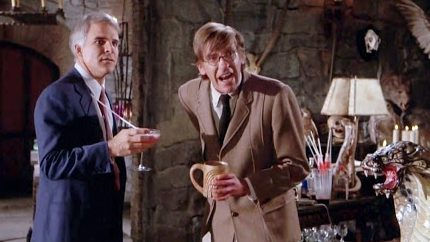The Man With Two Brains (1983)
- Soames Inscker

- Jun 7
- 4 min read
Updated: Jun 8

Released in 1983, The Man with Two Brains is a wildly inventive sci-fi comedy that serves as a hilarious satire of mad scientist tropes and classic horror conventions. Directed by veteran comedy filmmaker Carl Reiner, the film stars Steve Martin at the peak of his manic comic powers, paired with the sultry and dangerous Kathleen Turner. Their chemistry, combined with an absurdly inventive plot and a tone that swings from slapstick to black comedy, results in one of the most gleefully bizarre comedies of the early 1980s.
Plot Summary
Martin plays Dr. Michael Hfuhruhurr (a deliberately unpronounceable name, mined for recurring laughs), a brilliant but eccentric brain surgeon who has pioneered the "cranial screw-top" method of brain surgery. After the sudden death of his wife, Michael descends into lonely despair—until he accidentally hits beautiful but ruthless femme fatale Dolores Benedict (Kathleen Turner) with his car and falls madly in love.
Dolores, a classic noir-style gold digger, marries Michael purely for his wealth, tormenting him with her calculated cruelty and lack of physical affection. While on a medical conference in Vienna, Michael meets mad scientist Dr. Alfred Necessiter (David Warner), who has been keeping living brains in jars as part of a Frankenstein-esque experiment to transfer consciousness. Michael soon falls in love with one of the brains—specifically that of Anne Uumellmahaye (voiced by Sissy Spacek in an uncredited role)—with whom he can communicate telepathically.
As Michael’s relationship with the disembodied Anne deepens into a soulful and comic romance, a series of murders by the mysterious “Elevator Killer” adds tension and absurdity. The narrative ultimately builds toward Michael’s desperate quest to find a suitable body for Anne’s brain, leading to a series of absurd and darkly funny misadventures.
Performance and Characters

Steve Martin is in top comedic form, balancing slapstick, wordplay, and deadpan lunacy. His performance is all-in, whether he’s earnestly speaking to a jarred brain or screaming at a portrait of his dead wife. Martin’s physicality and timing anchor the film’s most ridiculous moments, giving them unexpected charm and commitment.
Kathleen Turner, fresh from her breakout role in Body Heat, spoofs her sultry screen image with relish. As Dolores, she’s both sexy and horrifying—a sociopathic seductress whose dialogue drips with camp. Turner’s performance is sharply tuned to the film’s tonal absurdity, and she makes an excellent foil to Martin’s desperate and naive doctor.
David Warner brings a touch of gothic menace and dry humor to his role as Dr. Necessiter, playing it straight in a world of escalating absurdity. His portrayal is a fine blend of sinister charm and scientific obsession.
The brain-voiced character of Anne, given life through the ethereal tones of Sissy Spacek, adds a surreal sweetness to the film, and the unusual love story becomes unexpectedly poignant.
Direction and Style
Carl Reiner directs with a confident hand, understanding the elasticity needed to balance the film’s camp sensibilities with moments of emotional sincerity. He leans into parody, skewering everything from classic horror films (Frankenstein, The Brain That Wouldn’t Die) to romantic dramas and Hitchcockian thrillers.
Reiner’s use of over-the-top sets, comically exaggerated sound effects, and melodramatic music cues helps create a heightened world that supports the film’s cartoon logic. The elevator scenes, recurring jokes (including Michael’s drunken rant at his deceased wife’s portrait), and visual gags are delivered with the precision of seasoned comedic minds.
Themes and Tone

Despite its silliness, The Man with Two Brains explores surprisingly substantial themes. It questions the nature of love, suggesting that true connection transcends physical form. The film’s central romance—between a man and a brain—parodies the superficiality of many traditional movie love stories, offering a bizarre but oddly heartfelt counterpoint.
The satire also extends to medical science, playing with fears about ethics, bodily autonomy, and hubristic experimentation. These themes are never treated seriously, but they enrich the film’s absurdism with satirical undertones.
Tonally, the film veers between slapstick, dark comedy, and romantic farce. Its offbeat humor won’t be for everyone, especially viewers expecting a conventional narrative or grounded logic. However, for fans of surreal, off-kilter comedies, the tonal oscillations are part of its charm.
Legacy and Impact
While not a massive box office hit upon release, The Man with Two Brains has achieved cult status over time. It stands as one of the more creative and risk-taking entries in Steve Martin’s 1980s oeuvre, alongside The Jerk and Dead Men Don’t Wear Plaid (also directed by Reiner). The film continues to be celebrated for its originality, quotability (“Get that cat outta here!”), and unabashed weirdness.
Its influence can be seen in later genre parodies and romantic comedies that push the envelope of absurdity, and it remains a favorite among fans of both Martin and Reiner’s uniquely anarchic comedic style.
Conclusion
The Man with Two Brains is a madcap delight—an outrageous, high-concept comedy that embraces lunacy with open arms and a screw-top skull. Powered by Steve Martin’s boundless energy, Carl Reiner’s assured direction, and a clever blend of genre parody and absurd romance, it remains a cult classic that rewards those who can tune into its bizarre frequency.
A surreal romantic horror comedy that manages to be both ridiculous and unexpectedly tender—a triumph of eccentric vision and comedic daring.






